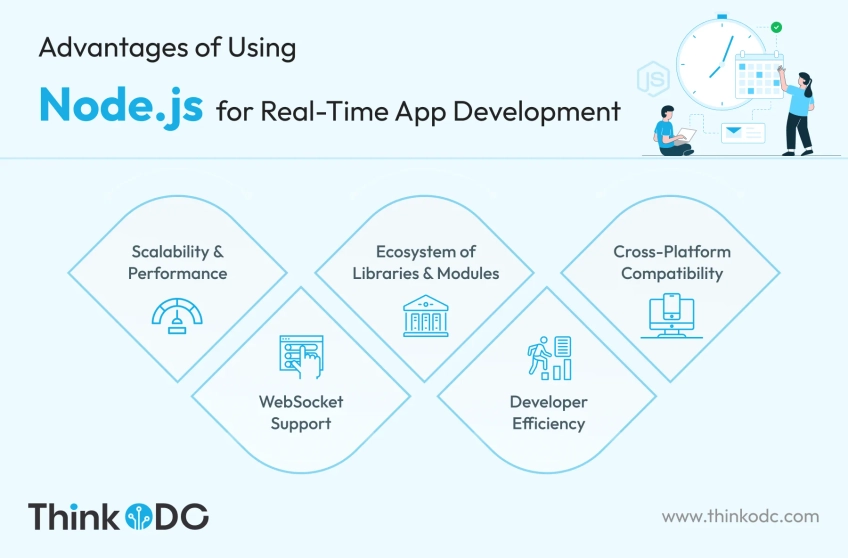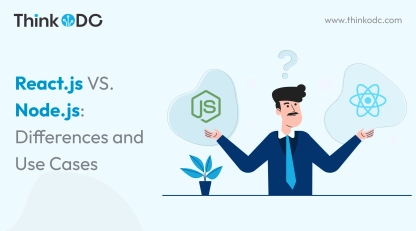In today's world, when it's all about keeping users engaged, fast, fluid, real-time experiences matter more than ever. Stale data and laggy response? Well, that's like waving goodbye to your customers.
This is where Node.js comes in.
Built on Google's speedy V8 JavaScript engine, Node.js enables responsive real-time communication between client and server. Its asynchronous event-driven architecture can support tens of thousands of concurrent connections with minimal overhead.
That is why industry leaders such as Netflix, PayPal, LinkedIn, and Uber rely on Node.js to build responsive real-time applications. From chat platforms used by millions to massive multiplayer games, Node.js empowers developers to build highly interactive web and mobile applications that feel instant and connected.
Do you know in 2023, Node.js overtook React.js as the most used web framework by developers worldwide? A recent survey found 42.7% of developers use Node.js, surpassing 40.6% using React.js.

In this article, we delve into the core advantages of Node.js that position it as the premier preference for developing real-time applications.
Benefits of Using Node.js for Real-Time App Development
When it comes to building fast, interactive real-time applications, Node.js has several advantages that make it a popular choice among developers.

Scalability and Performance
One of the most significant advantages of Node.js is its ability to efficiently handle a large number of concurrent connections and requests. The Node.js architecture uses asynchronous, event-driven I/O to minimize blocking and resource utilization. This allows it to support tens of thousands of concurrent connections with very low overhead.
Node.js utilizes a single-threaded event loop to handle all requests and events. This event loop delegates incoming requests to the application code as callback functions. If any callback initiates a blocking I/O operation, it gets handed back to the event loop rather than blocking execution.
This non-blocking, asynchronous architecture makes Node.js extremely scalable. It can deliver high throughput and low latency even with increasing traffic. For real-time apps requiring constant communication, Node.js is ideal for supporting huge user bases.
Additionally, using JavaScript on both front-end and back-end allows faster server-side execution without context switching. Overall, these capabilities make Node.js well-suited for performance-critical real-time applications.
WebSocket Support
Real-time applications rely on persistent connections enabling bidirectional communication between client and server. This is where the WebSocket protocol comes into play, as it allows for full-duplex communication channels to be established over a single TCP connection.
Node.js has excellent built-in support for WebSocket connections, simplifying real-time integrations. WebSocket enabled servers can push data to clients instantly without requiring frequent HTTP polling or long-polling. This makes achievable data updates in real-time without page refreshes.
For uses like online gaming and instant messaging, WebSockets are instrumental in delivering the expected real-time experiences. With Node.js, implementing WebSockets and associated handlers is straightforward and efficient. Rich Ecosystem of Libraries and Modules Node.js benefits from the expansive npm (Node Package Manager) ecosystem. npm hosts over 1.5 million open-source packages covering various functions and use cases. For real-time application development, there are many readily available modules:
- Socket.IO- Enables real-time bidirectional communication using WebSockets or polling fallback.
- Express- Fast and minimalist web framework for Node.js. Useful for server-side programming.
- WS- Simple to use WebSocket implementation.
- uWebSockets- Highly scalable WebSocket library.
These and countless other modules available on npm make it easier to implement real-time capabilities in Node.js. Developers can use existing solutions rather than reinventing the wheel.
Developer Efficiency
One of the oft-stated benefits of Node.js is the use of JavaScript across both server-side and client-side. This allows sharing code snippets, utilities, and modules across the full stack. Developers only need to learn one language, reducing the learning curve.
For real-time apps, shared model code improves efficiency. Real-time data structures and logic defined on the server can be reused for client-side updates. The same goes for utility functions, validation codes, and more.
Also, Node.js promotes code reusability and modularity with its CommonJS module system. Developers can create reusable modules containing features required across projects. The ability to import and reuse code enhances productivity.
Overall, the unified programming model and code reusability of Node.js boosts developer efficiency. This results in faster real-time application development.
Cross-Platform Compatibility
Node.js delivers cross-platform compatibility, enabling developers to write code once and run it across operating systems like Windows, Linux, and macOS. This portability stems from using JavaScript and not being tied to any specific OS.
For real-time apps, the ability to run the same codebase across platforms is a major plus. Developers don't have to maintain separate codebases or reimplement features. This results in huge time and effort savings.
Node.js makes it straightforward to develop real-time web and mobile apps that work seamlessly across different devices and platforms. Users enjoy ubiquitous access and fluid experiences.
Use Cases of Node.js in Real-Time App Development
Let's look at some typical use cases of Node.js delivering exceptional benefits for real-time application development:
Chat Applications
Instant messaging and chat apps have become immensely popular. Users expect real-time messaging capabilities allowing conversations to flow naturally.
Node.js is commonly used to create chat applications providing low-latency messaging. Using WebSockets, new messages can be pushed to users instantly without page refreshes. Popular apps like WhatsApp, Slack, and Facebook Messenger use Node.js and WebSocket connections to deliver real-time chatting.
With scalable event handling and fast I/O, Node.js processes huge volumes of chat data and propagation quickly. Features like typing indicators and read receipts can also be implemented effortlessly.
Online Gaming
For online multiplayer games, low latency and real-time data transmission are must-haves. Slow response times severely impact the gaming experience leading to lag and choppiness.
Node.js is an excellent choice for building highly responsive online games. Its non-blocking I/O and event loop allow fast data exchange and communication essential for real-time gaming interactions. Features like lobbies, matchmaking, leaderboards benefit from Node.js capabilities.
Top gaming titles like FIFA Online 3, Agar.io, and Rovio's Angry Birds employed Node.js to deliver smooth real-time gaming without lags. The scalability also handles spikes in gaming traffic effectively.
Collaborative Tools and Dashboards
Collaborative apps allow multiple users to simultaneously work on documents, data, or dashboards. They require real-time syncing of changes, so each user has an up-to-date view.
Node.js powers many popular collaborative tools like Google Docs, Trello, Asana, Figma, and Coda through its real-time capabilities. Using WebSocket connections, data edits or changes are quickly related to all active users.
Node.js is able to process high volumes of updates while keeping latency low. This enables smooth collaboration workflows rather than disjointed experiences. Real-time data visualization dashboards also leverage Node.js for live updates.
Read more: Discover the next big thing in Node.js development
Case Studies
Let's look at some real-world examples where companies leveraged Node.js for real-time application development:
-
Netflix- Netflix used Node.js to build a fast and responsive UI for smart TVs and mobile devices. By pre-computing API requests on the server, they reduced response times allowing almost instant UI updates.
-
LinkedIn- Optimized their mobile app using Node.js, cutting server response time from over 1 second to 30 ms. This provided extremely fast UI feedback and data updates.
-
PayPal- PayPal utilized Node.js to build their Instant Checkout feature, allowing one-click payments using stored credentials. Node.js helped scale to handle peak gift-giving season traffic smoothly.
-
MLB- MLB.com migrated their desktop and mobile apps to Node.js, reducing page load times by up to 10x. This provided real-time access to live game data and highlights.
In each case, Node.js solved latency and throughput challenges to deliver highly responsive real-time app performance. The apps provided slick UIs and near-instant data updates even under high traffic loads.
Potential Challenges and Mitigations
However, Node.js also comes with its set of challenges that must be handled thoughtfully. Here are some top challenges in Node.js development:
Callback Hell
The asynchronous, non-blocking nature of Node.js entails writing callback-based code which can quickly become deeply nested and difficult to manage. This "callback hell" hampers code maintenance and readability.
Thankfully, this can be mitigated by using promises or async/await syntax to flatten callback pyramids. Proper code modularization and separation of concerns also help avoid tangled callback logic.
Overusing Event-Driven Architecture
In some cases, overhead from excessive events and real-time data updates may emerge. If not architected carefully, this can affect performance instead of improving it.
Strategically determining when real-time updates are truly necessary can help optimize apps. Analyzing and aggregating data prior to syncing across clients also helps manage data flows efficiently.
Other Challenges
Managing a state in a distributed Node.js application can get complex. Race conditions may occur under heavy loads requiring safeguards. Node.js only utilizes a single CPU core which can impact compute-intensive tasks.
These challenges aren't insurmountable but do need sensible app structuring, testing, and monitoring. A well-planned architecture and using tools like load balancers and worker threads help overcome these hurdles.
To conclude, Node.js provides a highly scalable and efficient platform for building real-time web and mobile applications. Its event-driven architecture, WebSocket support, reusable code, and vast ecosystem enable developers to rapidly create responsive apps with instant messaging, live collaboration, push notifications and other must-have real-time features. For fast and engaging real-time user experiences, Node.js is the go-to choice.
Hire Node.js Developers from ThinkODC
Looking to build your next real-time web or mobile application using Node.js?
A Node.js development company, has an experienced team of dedicated developers to bring your vision to life. Our developers are experts in leveraging Node.js capabilities like scalable asynchronous I/O, WebSockets, and modular architecture to deliver fast, reliable real-time apps.
We follow proven best practices around performance tuning, testing, and monitoring to overcome common Node.js pitfalls. ThinkODC has a track record of building successful Node.js apps tailored to client needs.





